
The weather was warm and welcoming as we bounced along the track that led up to Robin’s Nest cottage, nestling in the southern foothills of Mt Nyangani, at 2 592 metres (8 504 feet) Zimbabwe’s highest peak. There were three of us in the old bakkie – my two artist sisters, Sally Scott and Nicky Rosselli, and I – and we were finally making a journey we had often fantasized about. Below us the land rolled and sloped in an emphatic way, criss-crossed by streams and patches of plantation and jumbles of granite hills which reflected silver in the bright sunshine. It was good to be back. There was a healing magic in the air and I could have all but shouted out with joy, I was so excited to be in the landscape of my youth.
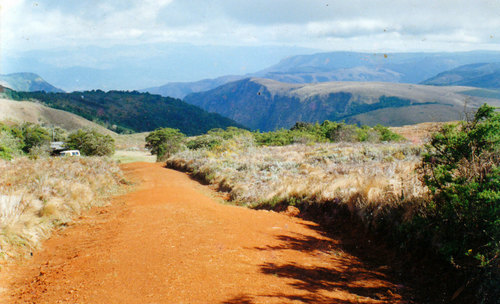
It was here I had made my first real discovery of that intangible sense of mystery some mountains have in abundance.
Sparse, rustic and startling basic, our windswept accommodation, could hardly have seemed more remote. Tucked away in a small grove of trees, it consisted of two wooden sheds linked by a roof of corrugated iron. It was like a hermits cell or the sort of place monks might have used when they wanted to get close to God. The two bedrooms with their rickety bunks were both extremely small. The kitchen area-cum- lounge, in the other section, contained a couple of battered, much-used, old chairs and a tiny wood stove which, I would soon learn, had a mind of its own.
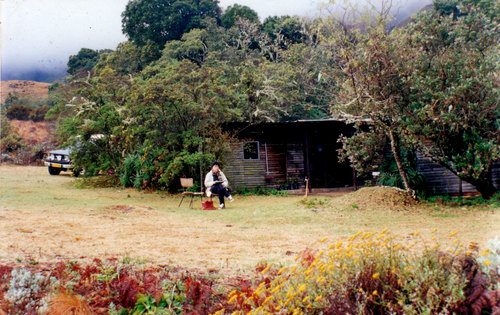
As I dumped my gear on the bed, I knew I was going to fall in love with the place. I have always been a bit of an ascetic with a taste for the Spartan. Robin’s Nest fitted my needs perfectly.
And if the building was on the ramshackle side, this, in no way, detracted from the magnificence of its setting. Directly behind us, the mist-shrouded mountain rose into steep pillars of rock, in front of us the land sloped away, gently at first, before suddenly plunging into a steep-sided, gaping abyss. The Nyazengu Gorge is not as well known as the Pungwe Gorge, into which it opens out, but, although of a smaller scale, it is equally beautiful. Protected from the worst of the winds but benefiting from the moisture-laden clouds they bring, it supports a profusion of plant life.
The morning sun was breaking through the cloud as we set out, early the next day, following a meandering path that led us over the downs. Everything about the morning was lovely. The call of the birds, the great blue sky, the sound of the river gurgling through the green hills. We hadn’t got too far when we came across some overgrown old stone-walled fortifications, remnants of what is now known as the Nyanga Uplands Culture. It seemed a bleak and lonely spot to have lived.
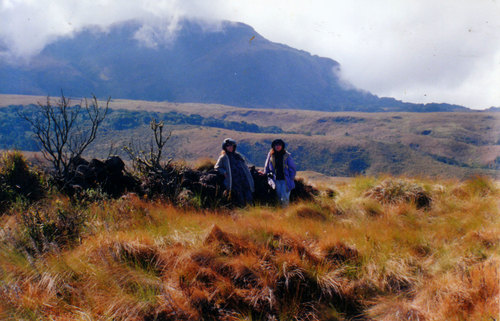
Still glorying in the voluptuous sunlight we pressed on along the path. Now and again we would find ourselves entering patches of dark remnant forest. Scattered through the undergrowth were numerous large, mossy boulders that looked like sleeping animals while, in other places, the trail was almost overgrown with ferns and low foliage.
Wherever we went there was that rich, yeasty smell of damp and decomposing matter. Adding to the slightly Middle Earth atmosphere was the wispy- white streams of Old Man’s Beard hanging down from some of the trees. Faraway from the shrieking commotion of city life, I felt like I had entered a very secret and enchanted place.
There were all sorts of birds here although, because of the gloom of the forest, they were not always easy to see. I did manage to get one “lifer”- the White-tailed Crested Flycatcher, a beautiful little bird with a penchant for fanning its handsome tail. Something of a rarity, its distribution in Southern Africa is restricted to the montane forests of Zimbabwe’s the Eastern Highlands and adjacent Mozambique. The even rarer Blue Swallow is also supposed to occur in the surrounding grasslands but I did not see any.
We emerged out of the cool shadows of the forest to find ourselves on the very lip of the gorge, at a point where a high waterfall plunged down its side and into the gloom below. Taking off my hiking boots, I dipped my big toe into the water and took it out very quickly indeed. It was every bit as cold as I feared it would be but at least it gave me the excuse to boil some tea to warm ourselves up.

Where the waterfall plunges into Nyazengu Gorge. 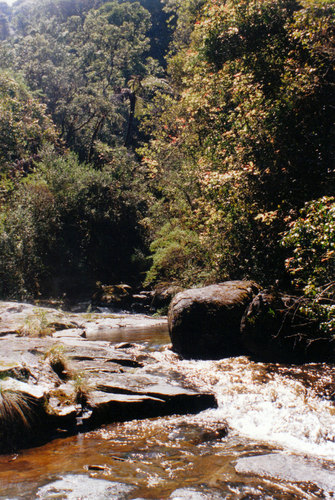
Upstream of the waterfall.
Later we squelched down a valley that was half bog, half rock until we came to another waterfall that tumbled down a massive sheet of exposed rock. It was hard to imagine anywhere more unvisited, wild and sublime. There was something about the way the sunlight sparkled on the beautiful, clear water, the way the light and water bubbled and swam together, the pure energy of the current flowing over the smooth grey rock that made us want to stop and tarry there. It was as if the water spoke best of the passion of the place.

More waterfalls… 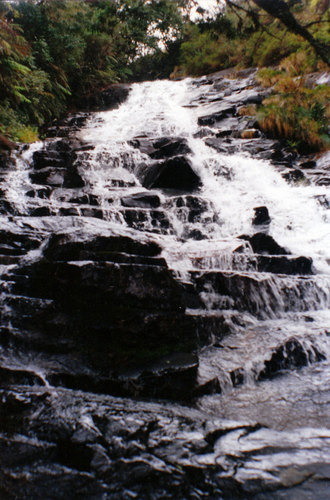
This was, of course, the other reason we had wanted to come back. All three of us are artists and we were looking for inspiration. There was no shortage of it here.
With its endless vistas and ever-changing moods and atmosphere, Nyanga has been a favourite venue for many painters including, most notably, Robert Paul. A friend of the British artist John Piper, Paul (1906-1980) – who has been described by Brian Bradshaw, the former director of the National Gallery in Salisbury (now Harare), as “a ‘genuine’ whose artistic dimensions exist not only in Rhodesia but would be recognised anywhere the values and evidence of art are understood” – returned to paint in Nyanga many times.
Deceptively slapdash in his brushwork, Paul had an uncanny ability to strip a scene down to its basics and select from nature only those elements which seemed to capture its essential spirit and feel. There is a perennial freshness about his work; in it. you immediately see a man who is comfortably at home in this scenery. It is why, whenever I am feeling homesick and want to reconnect with the landscape that exerted such a force on me in my childhood, I haul out a book* I have of his paintings.
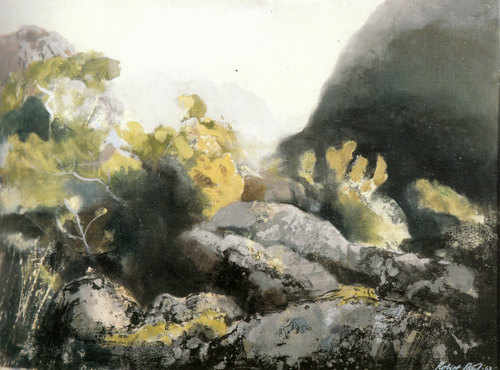
Inyangani 1967. By Robert Paul. Oil. 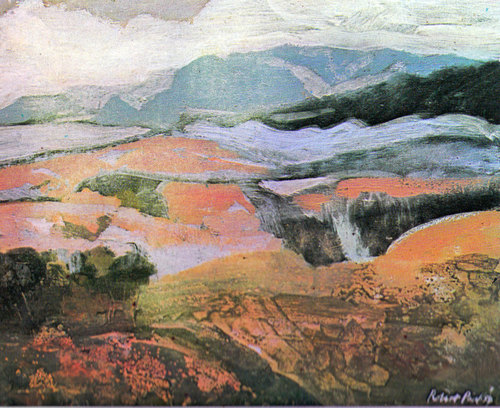
Inyanga Landscape 1950. By Robert Paul. Oil.
By the time we eventually tore ourselves away from this hallowed spot and headed home to Robin’s Nest, the cloud had begun to build up again along the mountain. We had barely made it back to the cabin when the whole area was engulfed in a thick tablecloth of mist. As night fell it grew intensely cold. Alone in our chilly hut, on the edge of that imposing mountain, it felt we had the universe all to ourselves.
Poking the wood stove to get more warmth, listening to the murmurings of the mountain and the soft conversation between the wind and the trees, I could not have been happier. I felt I had found a place set apart, one with that quality of isolated purity that helped restore the soul.
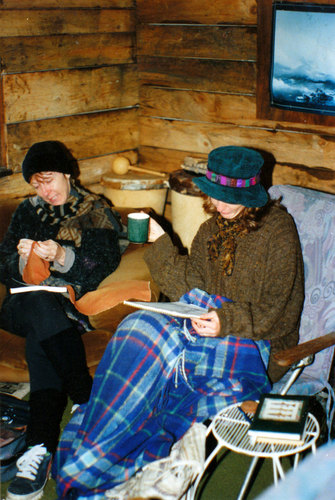
Sally and Nicky full of inspiration… 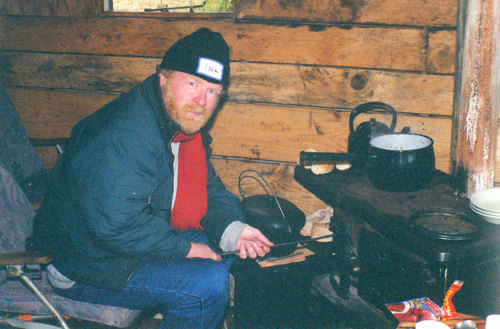
The keeper of the flame.
Although I had grown up in the area, I had never actually climbed Mt Nyangani. So I decided I was going to stir my old bones and make my way up to its summit. My sister Sally elected to join me.
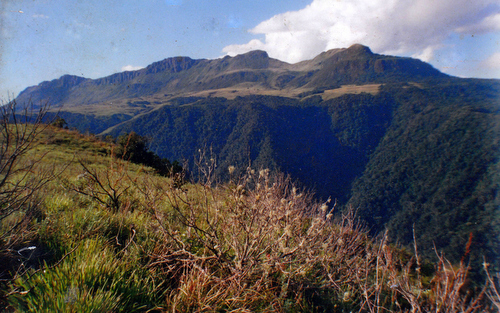
Although it is Zimbabwe’s highest mountain, the hike to the top only takes a few hours. The first section is the steepest to climb. Thereafter it opens up into a lush, gorse-covered, sprawling moors and undulating plateau.
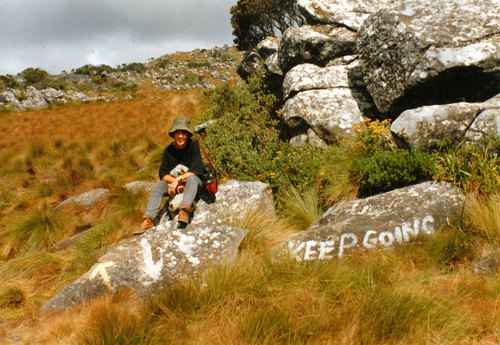
We were the only ones on the mountain that day which only added to the seremity of it all, the feeling of pure solitude.
It was well worth the initial slog, too, because the view from the top is one of the most beautiful I have ever beheld. Sitting on the apex of grey-green rock, with the sun shining through the clouds and anointing our heads, I really did feel like I was amongst the gods.
Geologically, Mt Nyangani is composed of an upper sill of dolerite and sandstone with the harder dolerite forming the cliffs on top of which, having reached the highest point, we now sat celebrating our achievement with a hot cup of tea (it’s my British ancestry). This, in turn, intrudes out of a sub-strata of ancient granite – the extensive Basement Complex that makes up much of the country’s geology and which has been gradually weathered away and exposed over the aeons.
On the eastern side of this high exposed ridge, lies the hot, humid Honde Valley, into which the countries highest waterfall, the 762 metre Mutarazi Waterfall, drops. It was also the scene of much fierce fighting during the Rhodesian Bush War. Extending from the border of Zimbabwe into Mozambique, its unusual position and topography cause it to have the highest rainfall in the country.
This is because moisture-laden clouds coming in from Mozambique are blown smack into the mountain wall and as they rise they cool and the rain comes. The constant watering has created a mini eco-system and the cliffs and crags here are covered in dense forest – making it quite distinct from the western side slopes which are mostly grassland, with only the odd tree hunched down again the bitter winter winds.
As one turns one’s eyes around further, the vast V-shaped Pungwe Gorge, with its tumbling, two-channel, waterfall, sweeps into view, followed by the entire Nyanga National Park and its environs. Beyond, that, shrouded in mystery lie, the ruin-strewed hills of Ziwa, and Nyahokwe and then, silhouetted, against the skyline, the massive granite dome of Mt Dombo. Crane your head still further and you will find yourself looking down the broad spine of the Nyanga escarpment to where both Mt Mouzi and the twin peaks of Nyangui mountain – whose beacon marked the edge of our old farm – jut out in the far distance.
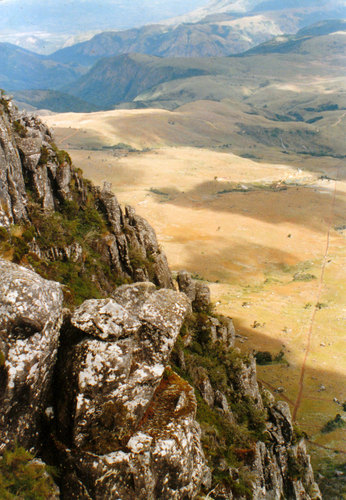
View down to Nyazengu Gorge and Honde Valley. 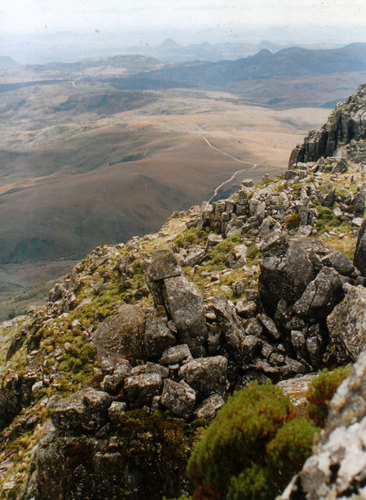
View towards Ziwa and Nyahowe
Three main rivers have their source on Mt Nyangani – the Nyamaziwa, the Gaerezi and the Pungwe. The first two are tributaries of the Mazowe which eventually flows north into the Zambezi. The Pungwe, which grows steadily wider as it follows its eastwards course, has its mouth in the Indian Ocean, at the port city of Beira in Mozambique.
Despite the relative ease of the climb Mt Nyangani has an ominous reputation. One local newspaper even went so far as to label it, in bold type, as “A MOUNTAIN WHICH SWALLOWS PEOPLE”. Others have, in equally dramatic terms, compared it to the Bermuda Triangle and Japan’s Devil’s Triangle. To some extent, its reputation as some sort of dark, hungry, malfeasant, force is well deserved for numerous hikers have indeed disappeared on the mountain never to be seen again.
Back in colonial times the word “Nyanga” was usually interpreted as meaning “place of the witchdoctor” which added further to the reputation of the mountain for being a bit of a scary, forbidden, place although the correct translation of the word is ‘herbalist ‘which has far less sinister connotations.
Like other sacred mountains in Southern Africa, Mt Nyangani has its prohibitions and taboos, including the fairly common stricture against pointing at it. No laughter is permitted either. The mountain is, also, subject to sharp weather changes particularly mist-build-up which make it easy to get disorientated and lost in. Hence, presumably, all those missing hikers who got ‘swallowed’ by the mountain.
We got first- hand experience of how quickly this can happen. I was posing for the obligatory Hail-the-All-Conquering-Mountaineer photo when I noticed a slight drop in temperature and a sudden jab of wind against the back of my neck. Pivoting around, I saw, to our immediate north, a low bank of cloud, glistening white in the sunshine. I think something about this sort of weather breeds an anxious hyper-alertness of the senses for I realised instantly it was time to get off the mountain.
As we hastened back down the track, more thin wisps of cloud began chasing one another along the mountain top towards us. I felt tiny splashes of rain. By the time we had got back to the parking area, the whole mountain, which had previously seemed so benign, had taken on a more sinister aspect.
We retreated down the road to the Nyangwe fort, just above Mare Dam, and sat on the rock walls watching the drama unfold. In the blink of an eyelid, Mt Nyangani was engulfed under a massive cumulonimbus cloud which, just kept growing and growing in size.
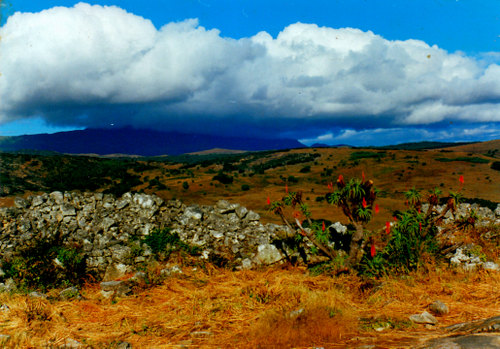
I was very glad we had got down in time to avoid being caught up in that vast, vortex of rising air. Awed by the spectacle, I found myself succumbing to all sorts of nagging, corrosive doubts. Maybe we had angered the mountain? Had I made a big mistake being so cheerful and upbeat as I posed for my vanity photographs? Was it some ill-humoured, demonic spirit that had sent that towering storm cloud?
I was not the only one with concerns about the mountain’s temperamental nature and sudden mood swings. Since we got to the summit, the park’s management has decided that you can now only climb it in the company of a guide.
And with a reputation like that who would not want to climb it?
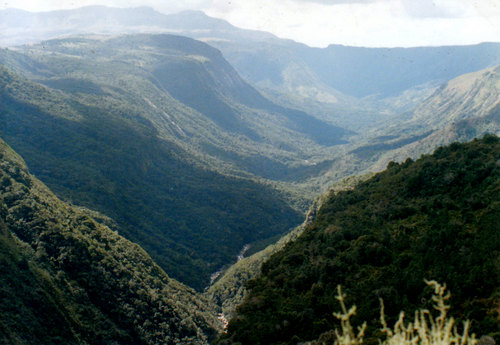
- *Robert Paul by Colette Wild, Brian Bradshaw, Francois Roux, Patricia Broderick and Martin Van der Spuy. Printed by Grillford Limited.
GALLERY:
Some artwork inspired by our trip:
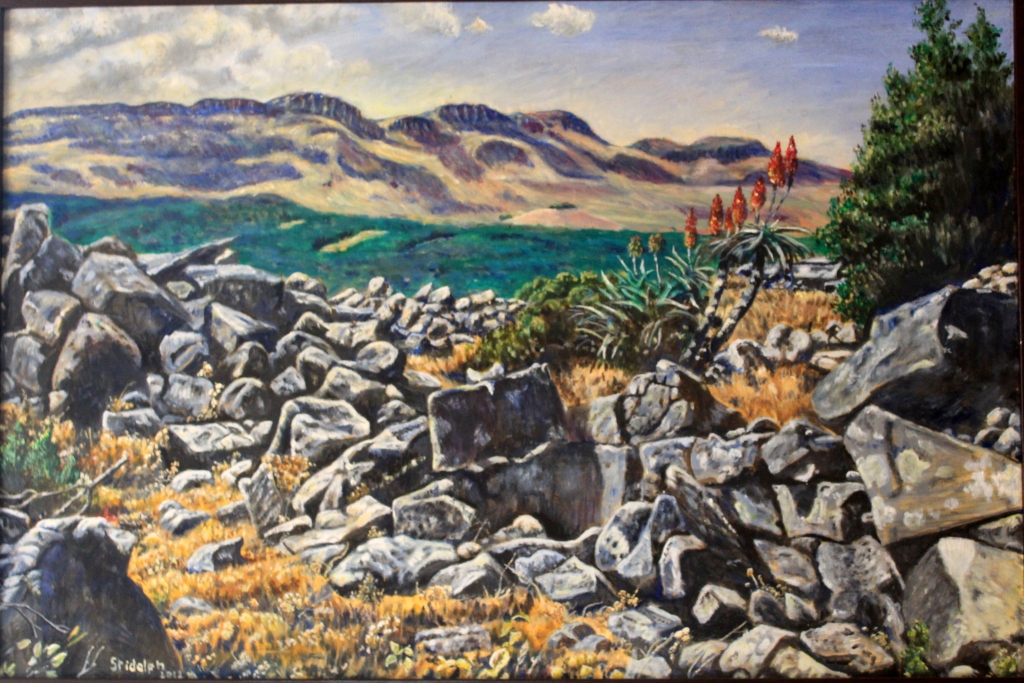
Mt Nyangani from Nyangwe Fort. Artwork by Anthony Stidolph. Oil. 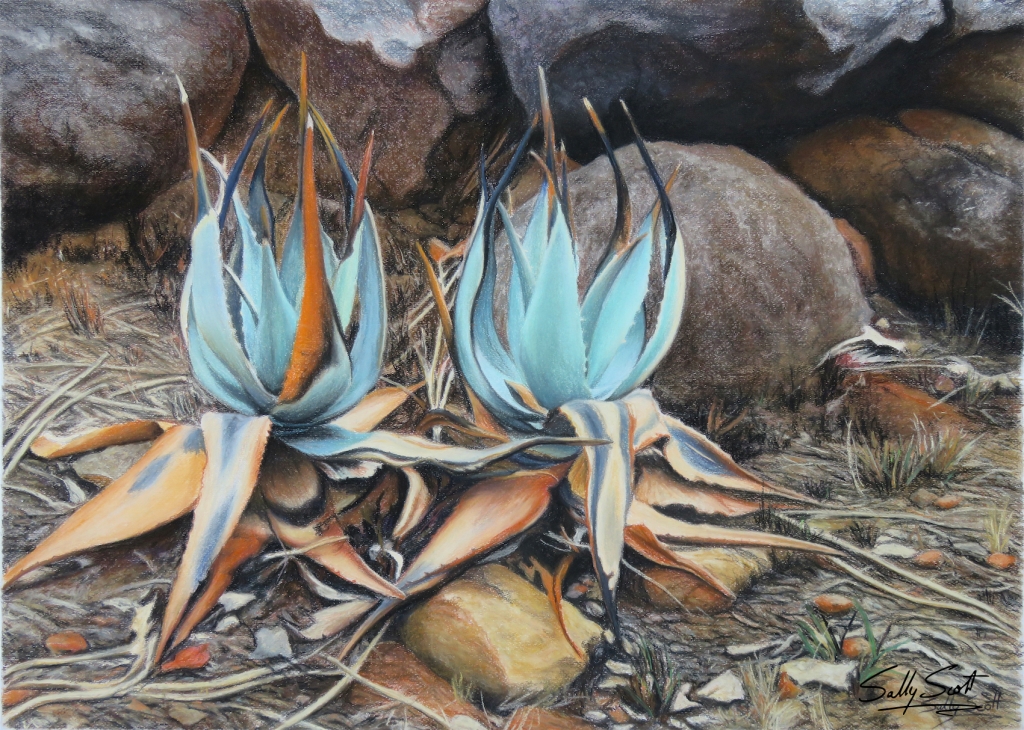
Nyangui aloes. Artwork by Sally Scott. Pastel. 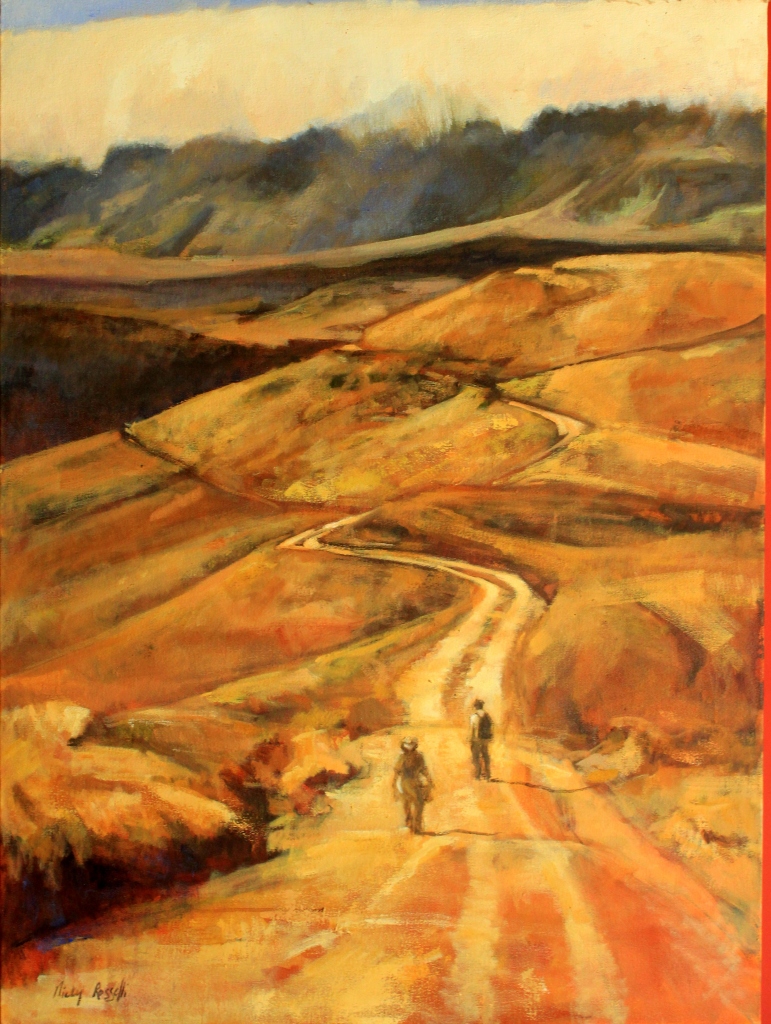
The Climb. Artwork by Nicky Rosselli. Oil. The two figures in the foreground are Sally and myself… 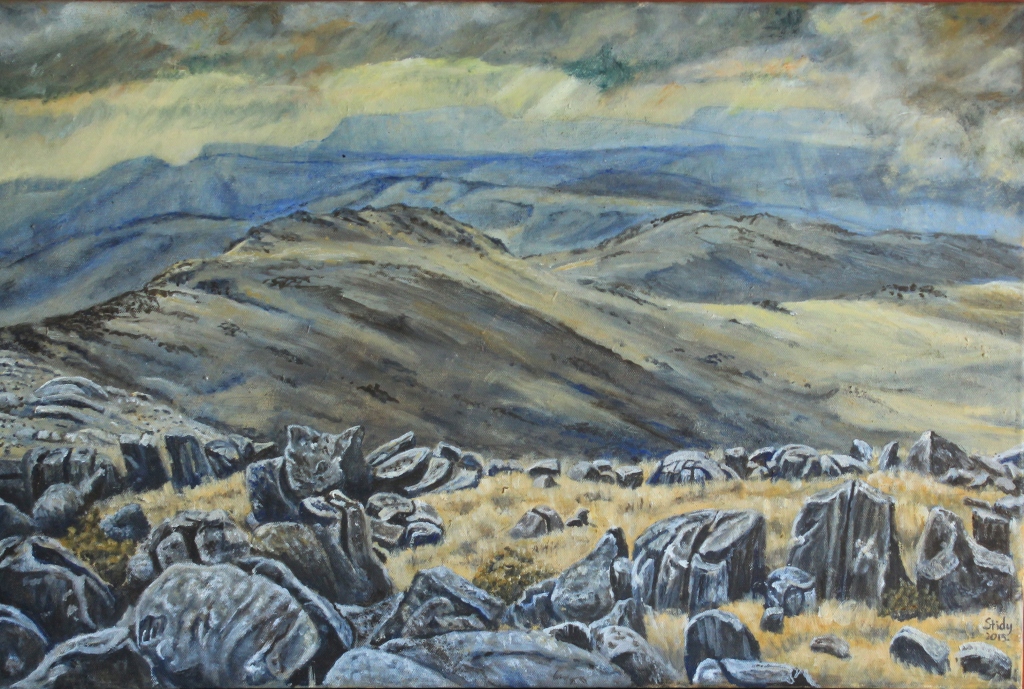
Summit of Mt Nyangani, looking North. Artwork by Anthony Stidolph. Oil. 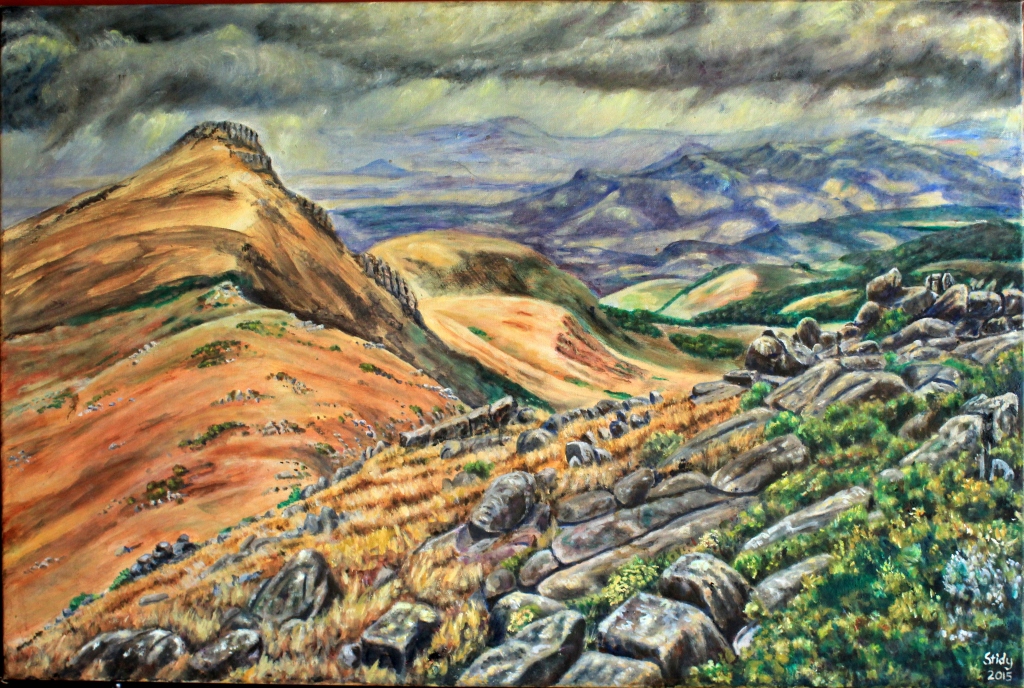
Summit of Mt Nyangani, looking South. Artwork by Anthony Stidolph. Oil.
A wonderfully descriptive account of a very unique and special experience. What a fantastic memory of something the three of you did together and the artworks from it are really evocative and beautiful.
LikeLike
Thanks, Mary-Ann. I must confess I did jot down a few thoughts some years afterwards and the old photos also brought back a lot memories. It was a special visit – as Nicky said we stayed in a small shack with an enormous view!
LikeLike
Hi Ant. Thanks very much for the story and pictures. You’ve been hiding your artistic talents all these years ! Beautiful pictures from you and your sisters. Was this a recent trip Ant. Very enterprising of you all of it was. All the best. Doug and Helen.
LikeLike
Thanks, Doug and Helen. Painting is something I came to rather late in my life so I still lack a little confidence in my abilities. As I am sure you will realise I am a huge fan of both my sisters’ work though! So good to hear from you both!
LikeLike
What a wonderful trip, so beautifully written and stunning artwork from a very talented family xx
LikeLike
Thanks, Sue. It certainly was a wonderful trip!
LikeLike
What a fabulous read! Beautifully written & illustrated, what incredible country.
The fact that you can write about it all these years later with such detail and so evocatively shows just what an amazing experience it must have been to be there. Jealous, I am.
And I had to smile wryly that for once you were the naughty party Stidy; in my opinion there is no doubt your behaviour angered the great mountain! Your misdeeds seem to have had a far greater effect than any of my wanderings into Botswana …
LikeLike
Thanks, Ken. It is a part of the world I feel a very strong, almost spiritual, connection with. I am still not sure what I did to offend the mountain though!
LikeLike
What agreat rip down memory lane Ant. I remember stories about kids going missing on a school rip years ago. I climbed it when I was 16 with friends but it was a hot , clear day. ( probably the last mt I climbed!) I do enjoy your posts, maybe the start of a book perhaps?? Keep well. xx
LikeLike
Thanks, Tawny. I am so glad to hear you are following my blog and enjoying it too! The book idea is a definite possibility. I was thinking about starting with a “Kusane Diary” but there are other possibilities. Love to all up there!
LikeLike